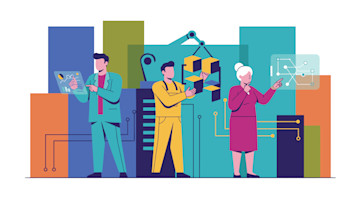Fifteen years ago, AMT noticed a gap between the advancements in consumer technology and the slower pace of innovation in the manufacturing sector. We asked a broad question: What would it take for manufacturing to move as fast as consumer technology?
One major challenge was a lack of unified standards, with vendor-specific proprietary tools perpetuating silos of data. AMT saw the need for a shared protocol to foster innovation and was uniquely positioned to champion this goal through The MTConnect Institute.
Setting I.T. Straight
The MTConnect Institute created an information model and semantic library known as MTConnect. Built to improve data interoperability, it uses standard markup languages and serves as an open-source vocabulary where structured data allows streamlined communication between machines.
Scalable and free, MTConnect is supported by an extensive open-source repository. Deployable with tools like Raspberry Pis, it is a low-cost and system-agnostic solution. Machines can produce and share useful data with dramatically lower setup and configuration costs, closing the gap with consumer tech.
After a decade of experience, the MTConnect Institute recognized that standards harmonization is a key enabler to developing emerging tools like digital twins, making MTConnect even more relevant. Where businesses have an existing digital twin framework, standardized machine data reduces the overall cost and decreases time-to-value. For those exploring digital twins, building systems from the ground up can improve the foundation of common data definitions.
Here’s how it works: Raw data from manufacturing equipment is structured and contextualized according to the MTConnect standard. The resulting information model for the equipment sits alongside geometric (CAD) data, kinematic chains, and other inputs to feed into digital twins, predictive maintenance models, reporting and remote control, and more.
Use Cases: Mazak & Boeing
MTConnect is already in use — equipment manufacturer Mazak designs its tools to accept MTConnect adapters and offers MTConnect-ready machines. Mazak’s plug-and-play catalog is a staple in Industrial Internet of Things (IIoT) applications such as efficiency monitoring, digital twins, and process optimization systems.
Enterprises like Boeing have also used this standard to build digital twins. Moving to a more dynamic process, Boeing implemented MTConnect with the ISO 23247 framework to sequence a team of fastening robots. Despite being a collection of different equipment, these robots work in concert to visualize and optimize tasks for each robot in the cell. It is an automatic, dynamic process with a fraction of the footprint of the original, monolithic machine. The upgrade is only possible due to a standard translating machine data across robots.
Data-DNA
Information plays a key role in model-based enterprises. More downstream information on upstream processes unlocks the predictive power of digital twins, but only when that data is solid. The MTConnect standard is the key to these applications; many third-party, open-source tools and countless more software vendors now rely on this initiative.
Learn more by visiting MTConnect’s website or visiting the About page.






